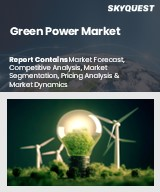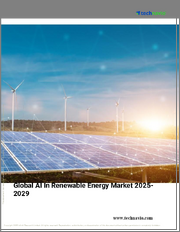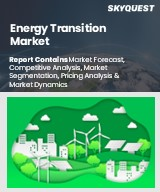
|
시장보고서
상품코드
1772723
그린 전력 시장 규모, 점유율, 성장 분석 : 유형별, 용도별, 최종사용자별, 지역별 - 산업 예측(2025-2032년)Green Power Market Size, Share, and Growth Analysis, By Type (Hydroelectric Power, Wind Power), By Application (Electricity Generation, Heating), By End User, By Region - Industry Forecast 2025-2032 |
||||||
세계의 그린 전력 시장 규모는 2023년에 601억 달러로 평가되며, 예측 기간(2025-2032년)의 CAGR은 12.3%로 성장하며, 2024년 674억 9,000만 달러에서 2032년까지는 1,707억 2,000만 달러로 성장할 전망입니다.
세계의 그린 전력 시장은 인구 증가, 산업화, 도시화로 인한 에너지 수요 증가에 힘입어 큰 폭의 성장이 예상됩니다. 재생에너지 발전에 대한 투자가 강화되고, 엄격한 배출 규제와 열병합 발전소 확대와 함께 녹색 전력의 매출이 증가할 것으로 예측됩니다. 또한 경제 발전을 촉진하기 위해 에너지 발전 능력을 높이기 위한 정부의 구상은 이러한 추세를 더욱 촉진할 것으로 보입니다. 그러나 설치 및 유지보수를 위한 고가의 초기 투자, 석탄 발전으로부터의 전환, 대기 오염과 관련된 환경 문제, 연료 공급망의 혼란 등의 문제가 녹색 전력 솔루션의 보급을 방해할 수 있습니다. 전반적으로 이러한 역학 속에서 시장은 유망한 궤도에 올라서고 있습니다.
목차
서론
- 조사의 목적
- 조사 범위
- 정의
조사 방법
- 정보 조달
- 2차와 1차 데이터 방법
- 시장 규모 예측
- 시장의 전제조건과 제한
개요
- 세계 시장 전망
- 공급과 수요 동향 분석
- 부문별 기회 분석
시장 역학과 전망
- 시장 개요
- 시장 규모
- 시장 역학
- 촉진요인과 기회
- 억제요인과 과제
- Porter의 산업 분석
주요 시장 인사이트
- 주요 성공 요인
- 경쟁의 정도
- 주요 투자 기회
- 시장 에코시스템
- 시장의 매력 지수(2024년)
- PESTEL 분석
- 거시경제 지표
- 밸류체인 분석
- 기술 분석
- 규제 분석
세계의 그린 전력 시장 규모 : 유형별·CAGR(2025-2032년)
- 시장 개요
- 수력발전
- 풍력
- 바이오에너지
- 태양에너지
- 지열 에너지
세계의 그린 전력 시장 규모 : 용도별·CAGR(2025-2032년)
- 시장 개요
- 발전
- 난방
- 운송
세계의 그린 전력 시장 규모 : 최종사용자별·CAGR(2025-2032년)
- 시장 개요
- 유틸리티
- 주택
- 상업
- 산업
세계의 그린 전력 시장 규모·CAGR(2025-2032년)
- 북미
- 미국
- 캐나다
- 유럽
- 독일
- 스페인
- 프랑스
- 영국
- 이탈리아
- 기타 유럽 지역
- 아시아태평양
- 중국
- 인도
- 일본
- 한국
- 기타 아시아태평양
- 라틴아메리카
- 브라질
- 기타 라틴아메리카 지역
- 중동 및 아프리카
- GCC 국가
- 남아프리카공화국
- 기타 중동 및 아프리카
경쟁 정보
- 상위 5사의 비교
- 주요 기업의 시장 포지셔닝(2024년)
- 주요 시장 기업이 채택한 전략
- 최근 시장 동향
- 기업의 시장 점유율 분석(2024년)
- 주요 기업의 기업 개요
- 기업의 상세
- 제품 포트폴리오 분석
- 기업의 부문별 점유율 분석
- 매출의 전년대비 비교(2022-2024년)
주요 기업 개요
- NextEra Energy(USA)
- Vestas Wind Systems(Denmark)
- Brookfield Renewable Partners(Bermuda/Canada)
- Iberdrola(Spain)
- Adani Green Energy(India)
- Canadian Solar(Canada)
- Orsted(Denmark)
- Enel Green Power(Italy)
- General Electric(GE Vernova)(USA)
- Siemens Gamesa Renewable Energy(Spain/Germany)
- JinkoSolar(China)
- LONGi Green Energy Technology(China)
- First Solar(USA)
- Acciona Energia(Spain)
- ReNew Power(India)
- EDP Renovaveis(Portugal/Spain)
- Sungrow Power Supply(China)
- Suzlon Energy(India)
- Clearway Energy(USA)
- NHPC Limited(India)
결론과 제안
KSA 25.07.23Global Green Power Market size was valued at USD 60.1 billion in 2023 and is poised to grow from USD 67.49 billion in 2024 to USD 170.72 billion by 2032, growing at a CAGR of 12.3% during the forecast period (2025-2032).
The global green power market is poised for significant growth driven by increasing energy demand fueled by population growth, industrialization, and urbanization. Enhanced investments in renewable energy generation, coupled with strict emission regulations and the expansion of cogeneration plants, are expected to elevate green power sales. Additionally, government initiatives aimed at boosting energy generation capacity to foster economic progress will further support this trend. However, challenges such as high initial investments for installation and maintenance, the transition from coal-based power generation, environmental concerns linked to air pollution, and disruptions in the fuel supply chain may hinder the widespread adoption of green power solutions. Overall, the market is on a promising trajectory amidst these dynamics.
Top-down and bottom-up approaches were used to estimate and validate the size of the Global Green Power market and to estimate the size of various other dependent submarkets. The research methodology used to estimate the market size includes the following details: The key players in the market were identified through secondary research, and their market shares in the respective regions were determined through primary and secondary research. This entire procedure includes the study of the annual and financial reports of the top market players and extensive interviews for key insights from industry leaders such as CEOs, VPs, directors, and marketing executives. All percentage shares split, and breakdowns were determined using secondary sources and verified through Primary sources. All possible parameters that affect the markets covered in this research study have been accounted for, viewed in extensive detail, verified through primary research, and analyzed to get the final quantitative and qualitative data.
Global Green Power Market Segments Analysis
Global Green Power Market is segmented by Type, Application, End User and region. Based on Type, the market is segmented into Hydroelectric Power, Wind Power, Bioenergy, Solar Energy and Geothermal Energy. Based on Application, the market is segmented into Electricity Generation, Heating and Transportation. Based on End User, the market is segmented into Utility, Residential, Commercial and Industrial. Based on region, the market is segmented into North America, Europe, Asia Pacific, Latin America and Middle East & Africa.
Driver of the Global Green Power Market
The increasing urgency of addressing climate change has positioned renewable energy as a vital component of the global energy landscape. Sources such as wind, solar, and hydroelectric power are crucial in reducing carbon emissions, supporting the commitment to international climate agreements. In response, both corporations and governments are establishing ambitious net-zero goals, which, in turn, drive heightened demand for green energy solutions. This collective shift towards sustainable practices not only enhances the appeal of renewable energy but also fosters a favorable environment for growth within the global green power market, highlighting its significance in the quest for a sustainable future.
Restraints in the Global Green Power Market
The Global Green Power market faces significant challenges due to the intermittent nature of many green energy solutions, which are heavily reliant on fluctuating weather conditions. This reliance creates hesitation among energy providers to fully commit to renewable sources without reliable strategies to manage energy consistency. While there are advancements in energy storage technologies, their high costs hinder widespread implementation. Consequently, these concerns around variability restrict the potential of renewable energy to completely supplant fossil fuels in meeting base-load power requirements, posing a significant barrier to the seamless transition toward a more sustainable energy landscape.
Market Trends of the Global Green Power Market
The Global Green Power market is witnessing a significant surge in the signing of Corporate Power Purchase Agreements (PPAs), particularly among major players in technology, retail, and manufacturing sectors. As corporations strive to meet ambitious net-zero emission targets and enhance their sustainability profiles, these long-term agreements allow them to source renewable energy directly from developers. This trend not only signifies a shift towards cleaner energy but also reflects a broader commitment to environmental stewardship, making PPAs a central component of corporate energy strategies. As a result, the green power market is poised for accelerated growth, driven by these proactive corporate initiatives.
Table of Contents
Introduction
- Objectives of the Study
- Scope of the Report
- Definitions
Research Methodology
- Information Procurement
- Secondary & Primary Data Methods
- Market Size Estimation
- Market Assumptions & Limitations
Executive Summary
- Global Market Outlook
- Supply & Demand Trend Analysis
- Segmental Opportunity Analysis
Market Dynamics & Outlook
- Market Overview
- Market Size
- Market Dynamics
- Drivers & Opportunities
- Restraints & Challenges
- Porters Analysis
- Competitive rivalry
- Threat of substitute
- Bargaining power of buyers
- Threat of new entrants
- Bargaining power of suppliers
Key Market Insights
- Key Success Factors
- Degree of Competition
- Top Investment Pockets
- Market Ecosystem
- Market Attractiveness Index, 2024
- PESTEL Analysis
- Macro-Economic Indicators
- Value Chain Analysis
- Technology Analysis
- Regulatory Analysis
Global Green Power Market Size by Type & CAGR (2025-2032)
- Market Overview
- Hydroelectric Power
- Wind Power
- Bioenergy
- Solar Energy
- Geothermal Energy
Global Green Power Market Size by Application & CAGR (2025-2032)
- Market Overview
- Electricity Generation
- Heating
- Transportation
Global Green Power Market Size by End User & CAGR (2025-2032)
- Market Overview
- Utility
- Residential
- Commercial
- Industrial
Global Green Power Market Size & CAGR (2025-2032)
- North America (Type, Application, End User)
- US
- Canada
- Europe (Type, Application, End User)
- Germany
- Spain
- France
- UK
- Italy
- Rest of Europe
- Asia Pacific (Type, Application, End User)
- China
- India
- Japan
- South Korea
- Rest of Asia-Pacific
- Latin America (Type, Application, End User)
- Brazil
- Rest of Latin America
- Middle East & Africa (Type, Application, End User)
- GCC Countries
- South Africa
- Rest of Middle East & Africa
Competitive Intelligence
- Top 5 Player Comparison
- Market Positioning of Key Players, 2024
- Strategies Adopted by Key Market Players
- Recent Developments in the Market
- Company Market Share Analysis, 2024
- Company Profiles of All Key Players
- Company Details
- Product Portfolio Analysis
- Company's Segmental Share Analysis
- Revenue Y-O-Y Comparison (2022-2024)
Key Company Profiles
- NextEra Energy (USA)
- Company Overview
- Business Segment Overview
- Financial Updates
- Key Developments
- Vestas Wind Systems (Denmark)
- Company Overview
- Business Segment Overview
- Financial Updates
- Key Developments
- Brookfield Renewable Partners (Bermuda/Canada)
- Company Overview
- Business Segment Overview
- Financial Updates
- Key Developments
- Iberdrola (Spain)
- Company Overview
- Business Segment Overview
- Financial Updates
- Key Developments
- Adani Green Energy (India)
- Company Overview
- Business Segment Overview
- Financial Updates
- Key Developments
- Canadian Solar (Canada)
- Company Overview
- Business Segment Overview
- Financial Updates
- Key Developments
- Orsted (Denmark)
- Company Overview
- Business Segment Overview
- Financial Updates
- Key Developments
- Enel Green Power (Italy)
- Company Overview
- Business Segment Overview
- Financial Updates
- Key Developments
- General Electric (GE Vernova) (USA)
- Company Overview
- Business Segment Overview
- Financial Updates
- Key Developments
- Siemens Gamesa Renewable Energy (Spain/Germany)
- Company Overview
- Business Segment Overview
- Financial Updates
- Key Developments
- JinkoSolar (China)
- Company Overview
- Business Segment Overview
- Financial Updates
- Key Developments
- LONGi Green Energy Technology (China)
- Company Overview
- Business Segment Overview
- Financial Updates
- Key Developments
- First Solar (USA)
- Company Overview
- Business Segment Overview
- Financial Updates
- Key Developments
- Acciona Energia (Spain)
- Company Overview
- Business Segment Overview
- Financial Updates
- Key Developments
- ReNew Power (India)
- Company Overview
- Business Segment Overview
- Financial Updates
- Key Developments
- EDP Renovaveis (Portugal/Spain)
- Company Overview
- Business Segment Overview
- Financial Updates
- Key Developments
- Sungrow Power Supply (China)
- Company Overview
- Business Segment Overview
- Financial Updates
- Key Developments
- Suzlon Energy (India)
- Company Overview
- Business Segment Overview
- Financial Updates
- Key Developments
- Clearway Energy (USA)
- Company Overview
- Business Segment Overview
- Financial Updates
- Key Developments
- NHPC Limited (India)
- Company Overview
- Business Segment Overview
- Financial Updates
- Key Developments



















